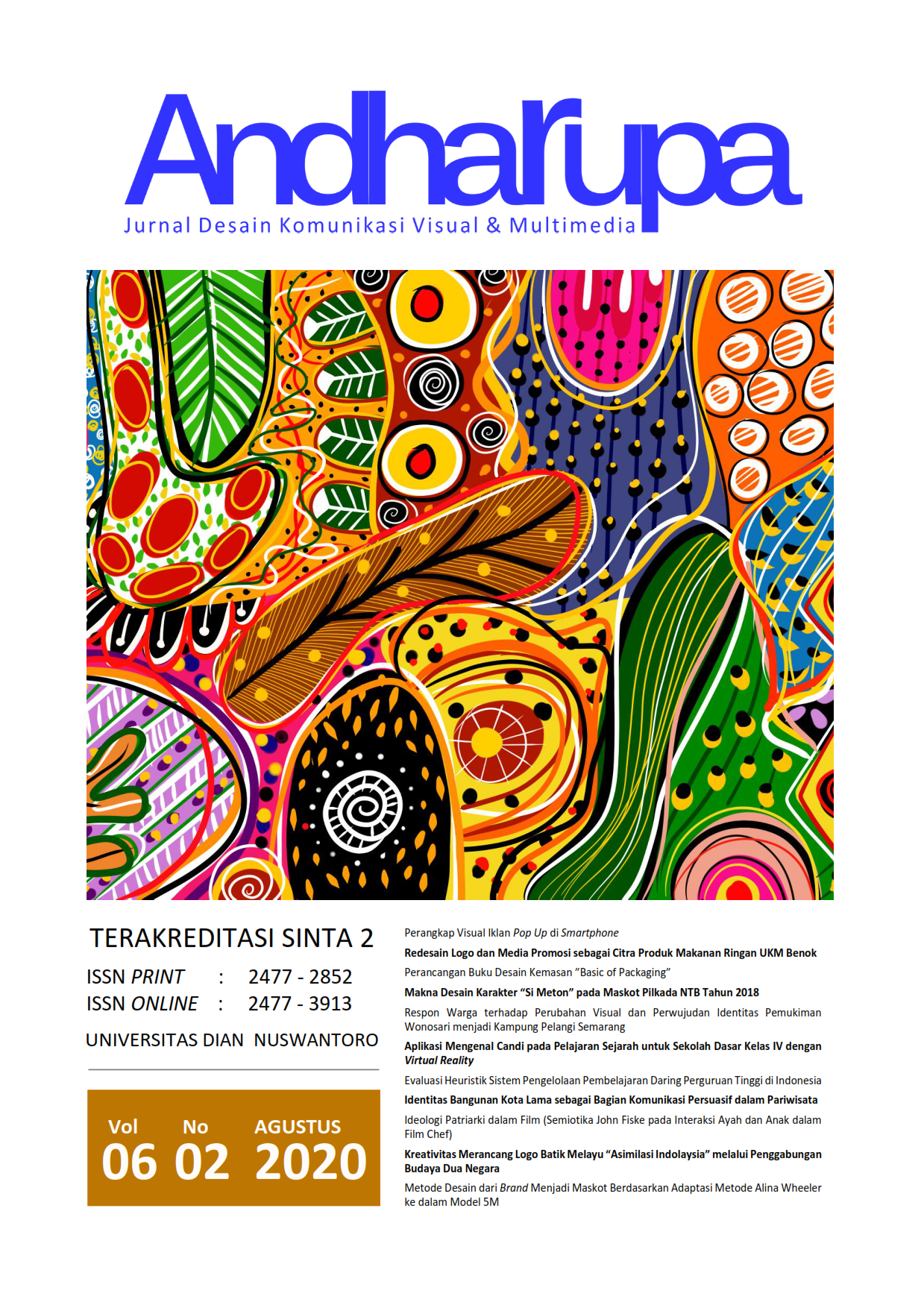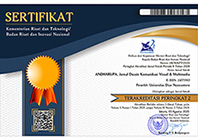EVALUASI HEURISTIK SISTEM PENGELOLAAN PEMBELAJARAN DARING PERGURUAN TINGGI DI INDONESIA
DOI:
https://doi.org/10.33633/andharupa.v6i02.3592Abstract
AbstrakPandemi virus Covid-19 pada awal tahun 2020 menyebabkan perubahan sistem pendidikan tatap muka ke sistem pendidikan daring. Berbagai jenis platform pembelajaran daring digunakan, salah satunya melalui sistem pengelolaan pembelajaran, Learning Management System (LMS). Perguruan tinggi di Indonesia telah mengembangkan materi ajar dalam LMS institusi masing-masing namun masih banyak kekurangan yang terdapat di LMS pembelajaran daring tersebut. Tujuan penelitian ini adalah menganalisis kebergunaan (usability) sistem tersebut termasuk materi ajar. Penelitian menggunakan strategi kualitatif dengan metode pengumpulan data dilakukan dengan pengamatan visual LMS. Data dianalisis menggunakan evaluasi heuristik dengan studi kasus pada beberapa penyelenggara pembelajaran daring. Interpretasi data diperkuat dengan studi literatur dari penelitian terdahulu. Dalam penelitian ini ditemukan permasalahan mayor pada materi ajar yang masih memakai elemen-elemen yang kurang tepat dan dapat menambah beban kognitif mahasiswa. Hasil penelitian ini memberikan beberapa rekomendasi yang dapat dijadikan salah satu pertimbangan dalam perancangan materi pembelajaran daring untuk perguruan tinggi di Indonesia. Kata Kunci: evaluasi heuristik, LMS, pembelajaran daring AbstractThe Covid-19 virus pandemic that occurred in early 2020 caused the education system to shift from a face-to-face education system to an online education system. Various types of online learning platforms are used, one of which is through the Learning Management System (LMS). Higher education institutions in Indonesia have developed learning materials in their LMS institutions. However, there are still many inadequacies found in their LMS. The aim of this study is to analyze the usability of the system, including the learning materials. The strategy of inquiry uses qualitative strategies, data collection method is made by visual observation of LMS. Data analysis using heuristic evaluation with case studies on several online learning providers. Data interpretation is strengthened by the study of literature from previous researches. This study found major problems in learning materials that still use elements that are not suitable and can add cognitive loads of students in constructing knowledge. The results of this study provide some recommendations that are expected to be one of the considerations in designing online learning materials for universities in Indonesia. Keywords: heuristic evaluation, LMS, online learningReferences
Adriyanto, A. R., Santosa, I., & Syarief, A. (2019). Memahami Perilaku Generasi Z Sebagai Dasar Pengembangan Materi Pembelajaran Daring. Prosiding Seni, Teknologi Dan Masyarakat #4, 2, 165–173.
Banindro, B. S. (2019). Pengembangan Techno Virtual Berbasis Website sebagai Media Pembelajaran Rekayasa Visual Blender 3D bagi Mahasiswa Desain Produk. ANDHARUPA: Jurnal Desain Komunikasi Visual & Multimedia, 5(01), 102–114.
Bhuasiri, W., Xaymoungkhoun, O., Zo, H., Rho, J. J., & Ciganek, A. P. (2012). Critical success factors for e-learning in developing countries: A comparative analysis between ICT experts and faculty. Computers & Education, 58(2), 843–855.
Cho, M., Kwon, S., Na, N., Suk, H.-J., & Lee, K. (2015). The Elders Preference for Skeuomorphism as App Icon Style. Proceedings of the 33rd Annual ACM Conference Extended Abstracts on Human Factors in Computing Systems - CHI EA ’15, 899–904.
Clark, R. C., & Lyons, C. (2011). Graphics for Learning: Proven Guidelines for Planning, Designing, and Evaluating Visuals in Training Materials (Second). San Francisco: Pfeiffer.
Erenler, H. H. T. (2018). Heuristic Evaluation of E-Learning. International Journal of Organizational Leadership , 7, 195–210.
Fakhruddin, D., Sachari, A., & Haswanto, N. (2019). Pengembangan Desain Informasi dan Pembelajaran Aksara Jawa melalui Media Website. ANDHARUPA: Jurnal Desain Komunikasi Visual & Multimedia, 5(01), 1–23.
Farmanesh, P., & Samani, A. A. (2016). Heuristic Evaluation of the Usability of Learning Management System (Moodle) at Eastern Mediterranean University. International Journal of Scientific Research in Information Systems and Engineering (IJSRISE), 2(1), 22–36.
Guo, P. J., Kim, J., & Rubin, R. (2014). How video production affects student engagement. Proceedings of the First ACM Conference on Learning @ Scale Conference - L@S ’14, 41–50.
Kemenristekdikti. (2018). Panduan Hibah Penyelenggaraan Sistem Pembelajaran Daring (SPADA) Indonesia Tahun 2018. Direktorat Pembelajaran, Direktorat Jenderal Pembelajaran dan Kemahasiswaan, Kementerian Riset Teknologi dan Pendidikan Tinggi Republik Indonesia.
Kemenristekdikti. (2019). Menristekdikti Umumkan Klasterisasi Perguruan Tinggi Indonesia 2019, Fokuskan Hasil dari Perguruan Tinggi. Retrieved July 12, 2020, from https://www.ristekbrin.go.id/kabar/menristekdikti-umumkan-klasterisasi-perguruan-tinggi-indonesia-2019-fokuskan-hasil-dari-perguruan-tinggi/
Kompas. (2020). Gotong Royong Studi Daring. pp. 9–9.
Kovacs, G. (2016). Effects of In-Video Quizzes on MOOC Lecture Viewing. Proceedings of the Third (2016) ACM Conference on Learning @ Scale - L@S ’16, 31–40.
Mayer, R. E. (2009). Multimedia Learning (Second). Cambridge: Cambridge University Press.
McNamara, D. S., & Kintsch, W. (1996). Learning from texts: Effects of prior knowledge and text coherence. Discourse Processes, 22(3), 247–288.
Nielsen, J. (1994). Usability inspection methods. New York: John Wiley & Sons.
Pappas, C. (2019). The 20 Best Learning Management Systems (2019 Update). Retrieved July 12, 2020, from https://elearningindustry.com/the-20-best-learning-management-systems
Spiliotopoulos, K., Rigou, M., & Sirmakessis, S. (2018). A Comparative Study of Skeuomorphic and Flat Design from a UX Perspective. Multimodal Technologies and Interaction, 2(2), 31.
Sulistiyawati, P., Prabowo, D. P., & Ulumuddin, D. I. I. (2017). Perancangan Media Pembelajaran Berbasis Audio Visual untuk Mata Kuliah Tipografi pada Program Studi Desain Komunikasi Visual Universitas Dian Nuswantoro. ANDHARUPA: Jurnal Desain Komunikasi Visual & Multimedia, 3(01), 69–80.
Thorngate, S., & Hoden, A. (2017). Exploratory Usability Testing of User Interface Options in LibGuides 2. College & Research Libraries, 78(6).
Zhang, D., Zhao, J. L., Zhou, L., & Nunamaker, J. F. (2004). Can e-learning replace classroom learning? Communications of the ACM, 47(5), 75–79.
Downloads
Published
Issue
Section
License
Copyright (c) 2020 ANDHARUPA: Jurnal Desain Komunikasi Visual & Multimedia

This work is licensed under a Creative Commons Attribution 4.0 International License.
Authors who publish with this journal agree to the following terms:
- Authors retain copyright and grant the journal right of first publication with the work simultaneously licensed under a Creative Commons Attribution License that allows others to share the work with an acknowledgment of the work's authorship and initial publication in this journal.
- Authors are able to enter into separate, additional contractual arrangements for the non-exclusive distribution of the journal's published version of the work (e.g., post it to an institutional repository or publish it in a book), with an acknowledgment of its initial publication in this journal.
- Authors are permitted and encouraged to post their work online (e.g., in institutional repositories or on their website) prior to and during the submission process, as it can lead to productive exchanges, as well as earlier and greater citation of published work (See The Effect of Open Access).















